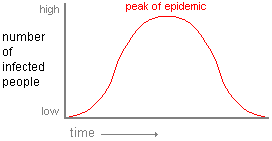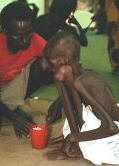Epidemiology
The modern western medical tradition uses the
scientific method to understand patterns of disease.
Epidemiology
![]() is
the name given to this kind of research. Epidemiologists are interested
in learning about the causes of diseases and how to cure or control them.
They also track the frequency and geographic distribution of diseases over
time. In addition, they study the causal relationships between diseases.
For instance, epidemiologists from the U.S. Centers for Disease Control and
Prevention in
Atlanta, Georgia work in countries throughout the world to
understand how HIV infection spreads from community
to community and why some untreated individuals do not go on to develop
AIDS.
is
the name given to this kind of research. Epidemiologists are interested
in learning about the causes of diseases and how to cure or control them.
They also track the frequency and geographic distribution of diseases over
time. In addition, they study the causal relationships between diseases.
For instance, epidemiologists from the U.S. Centers for Disease Control and
Prevention in
Atlanta, Georgia work in countries throughout the world to
understand how HIV infection spreads from community
to community and why some untreated individuals do not go on to develop
AIDS.
Epidemiologists find it useful to make a
distinction between epidemic
![]() and endemic
and endemic
![]() diseases.
Epidemic diseases
are ones that are often highly contagious but are not always present in a
community. They appear, rise rapidly in the number of cases, and then
decline or even disappear. Measles, influenza, and the plague are
examples of epidemic diseases. They usually appear seasonally as a
result of changing human interaction patterns and changes in the environment. In temperate regions, for
instance, people are more likely to be indoors in close physical proximity to
others during the winter. This provides an ideal environment for the
transmission of flu and cold viruses from person to person via airborne
aerosols produced during sneezing and coughing.
diseases.
Epidemic diseases
are ones that are often highly contagious but are not always present in a
community. They appear, rise rapidly in the number of cases, and then
decline or even disappear. Measles, influenza, and the plague are
examples of epidemic diseases. They usually appear seasonally as a
result of changing human interaction patterns and changes in the environment. In temperate regions, for
instance, people are more likely to be indoors in close physical proximity to
others during the winter. This provides an ideal environment for the
transmission of flu and cold viruses from person to person via airborne
aerosols produced during sneezing and coughing.
At the beginning of an epidemic, a contagious disease spreads at an increasing rate. As more and more people contract it, the chances of coming into contact with an infected person goes up rapidly. Towards the end of an epidemic, there are fewer and fewer unaffected people. Once most people have had it and either died or recovered, there are insufficient numbers of available new hosts to sustain the epidemic and it gradually disappears.
 |
 |
|
|
Epidemic disease pattern |
Endemic disease pattern |
Endemic diseases are ones that are always
present in a community, usually at a low, more or less constant frequency.
Malaria, arthritis, and high blood pressure are examples. At times, an
endemic is present at a continuously high frequency within a population.
In this case, it is referred to as a hyperendemic
![]() .
.
Many endemic diseases and most epidemic ones are
population density dependent. The higher the human density in an area,
the more rapidly they spread. As a result, they are far more likely to infect people
in cities than in rural areas with dispersed settlement
patterns. If the circumstances are optimal for the spread of
contagion and if few people have an immunity to a disease, there can be a
pandemic
![]() .
This is an epidemic that becomes unusually widespread and even global in its
reach. Such a situation occurred in 1918 when a new strain of the
influenza virus (the "Spanish flu") infected 1/5 of all people in the world
and killed 20-40 million of them.
.
This is an epidemic that becomes unusually widespread and even global in its
reach. Such a situation occurred in 1918 when a new strain of the
influenza virus (the "Spanish flu") infected 1/5 of all people in the world
and killed 20-40 million of them.
Pandemics have been relatively common since the beginnings of the ancient civilizations 5,000 years ago. Periodically they have caused misery and death on a massive scale. For instance, plague swept through Western Asia and Europe during the 14th century A.D. killing up to 3/4 of the population of infected regions. At least 25 million Europeans died in this pandemic in less than 20 years. Within a century of the arrival of the first European conquerors in the heart of the Aztec Empire of Mexico in 1519, as much as 90% of the indigenous population had died from common European contagious diseases for which the Indians had little or no immunity. The native civilizations of the Americas were defeated as much by viruses as they were by swords and guns.
Disease Vectors
The spread of contagious diseases is not always as simple as someone coughing on another person. There may be intermediate hosts and/or disease transmitting organisms. The latter are referred to as disease vectors. Mosquitoes, fleas, lice, ticks, flies, and even some snails are common vectors for some diseases. For instance, malaria can be caused by any one of four different plasmodia (a category of single celled organism). These plasmodia are parasites that need hemoglobin in red blood cells. They are transmitted from host to host unintentionally via blood sucking mosquitoes. Plague is caused by the bacterium Yersinia pestis. Its normal host is wild rodents and other small mammals. However, it can be spread to people by fleas that suck blood from those animals and transmit it to humans when they extract their blood. Once an epidemic of the plague begins, fleas can easily spread the disease from one human host to another. Flies are known to carry bacteria on their legs from feces to food. This is one of the ways in which bacterial dysentery is spread.
Close to half of the people in the world today have chronic diseases that are vector-borne. Third world nations in tropical and subtropical regions are the most effected. Vector-borne diseases cause high levels of physical disability and low life expectancies in those countries.
MAJOR VECTOR-BORNE DISEASES
Tropical and subtropical
regions of the world
North AmericaAfrican trypanosomiasis Lyme disease Dengue fever Malaria Dracunculiasis Rocky Mountain spotted fever Leishmaniasis Viral encephalitis Lymphatic filariases Malaria Onchocerciasis (river blindness) Schistosomiasis (bilharziasis)
Diseases of Development
Until well into the 20th century, the most common debilitating diseases in industrialized nations were caused by worms and microorganisms (tape worms, round worms, viruses, bacteria, protozoa, fungi, etc.). These parasites, along with malnutrition, still cause most of the major health problems in the poorer nations. They result in high child mortality rates and often cause long term health problems. Malaria is one of the prime causes of illness in third world countries of the tropical and subtropical regions. It infects one out of ten people on earth today. The World Health Organization estimates that there are close to 100,000,000 new cases of malaria annually around the world. It results in 1-1.5 million deaths every year. Most of them are pregnant women and children. About 3,000 children die of malaria every day. Most of the malarial deaths are in the poor nations, especially in Africa. Diarrhea is also a major killer of babies and young children in those nations. It results in the death of nearly 1400 of them every day. In 2003, the Division of Policy and Planning of the United Nations Children's Fund estimated that more than 63% of the 10.8 million children under five years old who succumb to relatively common preventable illnesses such as diarrhea and pneumonia each year could be saved by doing what we already know how to do. It would be possible to prevent more than 6 million children a year from dying by improving nutrition, sanitation, and basic medical care.
During the last half of the 20th century, it became apparent that good intentioned attempts by the rich nations to improve the life of people in the third world often have unexpected consequences. They can cause diseases of development. These are due mostly to environmental changes, increased population densities, and pollution. In West Africa and Egypt, for instance, there has been a dramatic increase in the frequency of schistosomiasis and/or onchocerciasis resulting from river damming projects designed to produce electricity and enhance irrigation systems. The dams slow the flow of rivers, thereby creating favorable environments for the organisms that transmit the parasites that in turn cause these diseases.
In most third world nations, there has been a mass migration of poor people to the cities during the last half century. The burgeoning populations of these urban centers often become far too large for the capabilities of their sewage processing systems. As a result, feces born diseases such as cholera and dysentery have become serious public health problems. The common practice of burning garbage on the streets of third world cities and in unofficial dumps also results in the accumulation of dioxins and other dangerous cancer causing substances on the ground and in water supplies.
|
This link takes you to a video at an external website. To return here, you must click the "back" button on your browser program. (length = 4 mins, 52 secs) |
Increased air pollution in large cities around the world has resulted in higher lung cancer and asthma rates. Allergies and other autoimmune diseases are also on the rise. These conditions have been linked to environmental factors such as air pollution and man-made chemicals.
Modern medicine has at times been responsible for causing health problems. For instance, during the mid to late 1950's a drug named thalidomide was given to many pregnant women in Europe and North America in order to reduce the unpleasant symptoms of morning sickness. Only later was it discovered that thalidomide causes severe anomalies in babies. Many were born without arms or legs. Others had extremely small appendages that were essentially non-functional.
|
|
|
|
The consequence of |
Serious nutrition related problems in the third world are responsible for high child mortality rates. In Pakistan, 15% of the children die before their fifth birthday. The rate is 18% in Cambodia and 22% in Afghanistan. Persistent undernourishment among children also can cause permanent mental and physical developmental problems such as stunted growth, rickets disease, and low levels of mental retardation. Severe vitamin A deficiency can cause blindness and birth defects such as cleft palate. Low protein intake can cause kwashiorkor. The poverty that most often is the ultimate source of these devastating health problems in poor nations is usually a result of natural and man-made ecological disasters as well as social and economic inequalities.
The rich nations are not immune to nutrition related diseases. Diets that include too many calories and especially high amounts of animal fats have been connected with obesity, diabetes, and hypertension. There is also reason to be concerned about the loss of nutritive value resulting from industrial scale food production and processing practices.
This page was last updated on
Thursday, July 13, 2006.
Copyright 2002-2006 by Dennis
O'Neil.
All rights reserved.
Illustration credits
